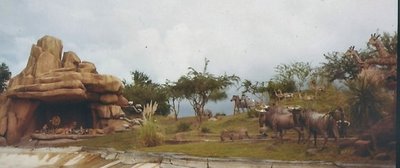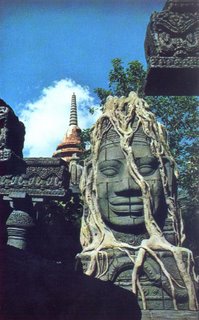 The final evolution for the Jungle Cruise took place in 1971 with the opening of
The final evolution for the Jungle Cruise took place in 1971 with the opening of Blessed with unlimited space and no restrictions, Imagineers this time sidestepped the rather abrupt opening of the California version by designing entirely new scenes leading up to the first major tableau, the Great African Veldt, and dispersing the major set pieces more evenly through the attraction. Guests now first visited giant but harmless butterflies in a misty rain forest, then stopped to admire beautiful volcanic waterfalls to set the right tone of tropical whimsy, but immediately thereafter sailed through a shaded, narrow waterway towards ominously abandoned native canoes before encountering their first animal: a giant python. Subsequent animals encountered become larger and larger until, for the first time, the foliage parts and the veldt rolls into view, complete with lions in a brand new cave.
 Walt Disney World's original veldt; notice the "boundless horizon" effect, since filled in due to devolpment.
Walt Disney World's original veldt; notice the "boundless horizon" effect, since filled in due to devolpment.Elements that worked were kept, often expanded – as in the case of a g igantic new Schweitzer Falls, which dumped almost twice the amount of water its’ predecessor did, and was placed midway through the attraction. The major departure from the
igantic new Schweitzer Falls, which dumped almost twice the amount of water its’ predecessor did, and was placed midway through the attraction. The major departure from the  eal perfected in an attraction like The Haunted Mansion, but now in the much more open and free unit of the jungle boat. A small rightward turn on the start and end of the almost-circle makes it possible to perfectly reveal a menacing
eal perfected in an attraction like The Haunted Mansion, but now in the much more open and free unit of the jungle boat. A small rightward turn on the start and end of the almost-circle makes it possible to perfectly reveal a menacing
Marc Davis designed new scenes for this version including a base camp overrun by gorillas, a gorilla batting at a crocodile, a bird on a branch being menaced by crocodiles, a brand new Trader Sam, abandoned pygmy war canoes, and others.
In 1976 as many successful elements of the
 The difference a designer makes: Jungle Cruise character design before and after Marc Davis.
The difference a designer makes: Jungle Cruise character design before and after Marc Davis.
Return next week for Part Three and more photos!


